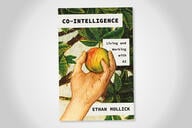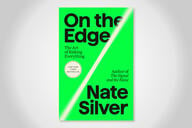You have /5 articles left.
Sign up for a free account or log in.

Routledge
The Chief Online Learning Officers’ Guidebook is now available for order. As one of the (many) contributors that Jocelyn Widmer and Thomas Cavanagh brought together to participate in the book, I was especially excited to receive my copy in the mail. Reading through the book, I’ve found it fast-paced, informative and sometimes provocative. To help spread the word about the book, I asked if its authors, Jocelyn Widmer and Thomas Cavanagh, would answer my questions.
Q: Can you share the book’s origin story with us? Why did you write it and what was your process from idea to published manuscript?
A: The COLO Guidebook started as a series of conversations. As conferences started to transition back to face-to-face, Jocelyn began connecting with colleagues she had largely met online during the pandemic. She found herself asking sitting COLOs the same seven-ish questions. These conversations were intended to inform her efforts to continue building a unit dedicated to academic innovation.
We connected during the pandemic over shared responsibilities around supporting student populations at scale and were able to sit down in person during the summer of 2022. From there, Tom hosted Jocelyn on his popular TOPcast podcast, where more insights were shared around the many conversations with COLOs that Jocelyn had been able to accumulate. Fast forward a few months and Tom was co-chairing UPCEA’s C-COLO group. He invited Jocelyn to present her findings from the conversations she had had with COLOs over the past year, which eventually became the foundation for the chapters in The COLO Guidebook. With Tom’s encouragement, we had ensuing conversations about turning those insights into a book.
We began to organize the content not only around the insights gleaned from the conversations Jocelyn had had, but also added another layer to focus these insights on the eight competencies that UPCEA had developed for professional and continuing online leadership. From here, the chapters really started to organize themselves into an introductory section, where we define the COLO role and trace its origins through a comparison to the evolution of the CIO role. Section two is the real substance of the book in terms of the strategic dimensions of the COLO role, and section three positions the COLO role on a future-facing trajectory with an emphasis on building a pipeline and also sustaining the role as one lever in safeguarding higher education’s relevance.
With the outline of the book solidified, we wanted to ensure our experiences and insights were complemented by the leading voices in the COLO and COLO-adjacent space. Given our collective networks, we started filling in names with an eye toward diversity of institution type, career experience and ensuring we were assembling the luminaries in the field. Somewhat to our surprise, nearly every individual we approached about participating in the book said yes!
From here, it was really a numbers game. We were up against a word count limit, so we distributed three to four expert perspectives across each chapter. We wrote the spine of each chapter (plus or minus 2,000 words) and our expert contributors had free rein to pen their perspective related to the chapter topic they were assigned. The end result is a 13-chapter book in three sections with 54 expert perspectives woven throughout. You’ll see a large swath of these expert perspectives coming from COLOs at various stages of their careers, as well as perspectives from CIOs, leaders in ed tech, a handful of university presidents and representation from each of the major online professional organizations. These perspectives represent a moment in time amidst the decade of the COLO, as Bob Hansen, CEO of UPCEA, writes in his foreword.
Q: What are some of the big themes from the book? What are some of the ideas from the expert contributors that came as surprises?
A: You’ll find expert perspectives with a range of titles, positioning and jurisdictions from a diversity of institutions. We think this adds to the value of the book. From this diversity several key themes emerged:
- There is no one clear career trajectory to becoming a COLO.
- Your reporting line is your destiny.
- Networking is imperative.
- Emerging COLO competencies are redefining UPCEA’s eight hallmarks in real time.
Arguably, most surprising was that each of the expert contributors wrote perfectly in alignment with the objectives of each chapter. We didn’t receive any content that was a dangling modifier, if you will. This speaks to several truths of the COLO role that we suspect many sitting COLOs perceive to be unique to their institution and/or respective role. And perhaps not surprisingly at all was the challenge of getting our expert perspectives down to 750-ish words (emphasis on the “-ish”). This speaks to the depth that stands to be explored with the COLO role.
For example, while we do touch on AI and other emerging technologies that will impact the role, that’s a topic that could probably justify its own stand-alone book (e.g., “AI and the COLO”). Lastly, one area we struggled with and ultimately had to table for the future was the international COLO perspective. There were simply too many permutations of institutional partnerships, learner populations and regional nuances to give the international perspective the real estate it deserves in The COLO Guidebook. While we recognize that many of our expert contributors have international experience as either part of their current role or in their prior experience, including ourselves, we just weren’t equipped to include this dimension in The COLO Guidebook.
Q: How do you think the book might grab the attention of academic leaders other than those who work on online programs? How do we get deans, provosts and presidents to read it?
A: We wrote the book with four main audiences in mind. First, sitting COLOs. With over 50 expert perspectives included in The COLO Guidebook, many of whom are COLOs, we recognize that our audience on this front is limited. We also wrote the book for aspiring COLOs. We delve into many topics surrounding how to prepare oneself, from career pathing to networking opportunities and all of the other competencies that UPCEA has articulated. We also included the expert perspectives of several new COLOs to speak to this audience in particular. Our third audience is those top academic leaders—university provosts and presidents in particular. We know that when new COLO positions are posted, they are often originating from a need identified by a provost or a strategic initiative of the president.
We all read these position descriptions and can tell right away if these leaders understand what a COLO does and the impact they can have on the university or if it’s a grab-bag position with aspirations and expectations that no one person or unit could ever meet. As new COLO positions surface and/or existing COLO positions are updated and refreshed, it’s imperative that academic leaders understand the role as we have explored it in The COLO Guidebook. This not only sets the individual COLO up for success, but also the institution.
The last audience is ed-tech leaders. This is an important group that COLOs intersect with frequency. These positions in ed-tech companies are often thought leaders for COLOs, particularly those who have transitioned out of academia and into the corporate space. We are hearing from our ed-tech friends that some are purchasing The COLO Guidebook for their teams as a way of upskilling them on the role that they intersect with.
As to how we get provosts and presidents to read the book, we started by including the expert perspectives of four sitting university presidents. These perspectives are mostly aggregated in Chapter 12: Safeguarding Higher Education’s Relevance. Some of these individuals have ascended into their role from previous COLO positions, whereas others have championed a deep commitment to access and flexibility for learners, which starts with online and digital learning. We propose that to effectively serve the 21st-century postsecondary student, institutions must have a digital learning strategy.
That strategy can take many different forms, from a completely online institution to simply posting the syllabus in the LMS—and everything in between—but refusing to have a strategy is no longer an option. Smart strategic presidents and provosts will recognize the tremendous asset that digital learning is for accomplishing institutional goals such as access, retention, student success, time to graduation and revenue generation. This book can help presidents and provosts to support a key senior leadership role to oversee this strategic digital learning enterprise.
Additionally, UPCEA’s endorsement of the book, including Bob Hansen’s foreword, highlights that we are amidst the “decade of the COLO.” UPCEA’s endorsement, along with amplification by the major online professional organizations, we hope will elevate the profile of The COLO Guidebook so that it’s on the radar of university provosts and presidents well into the future.





